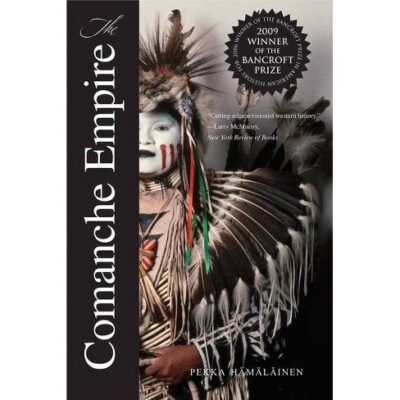
Back in December, 2022, I wrote a blog about scholarship related to the Comanche Empire. It had crossed over from the academic arena to the public one due to press coverage back in September 2022 in The New York Times (Peoples of Agency or Victim-hood?: Africans and Indians December 13, 2022). The reason for the blog was the scholarship reported on in the paper repositioned Indian nations from being thought of as victims to being thought of as having agency or being players … at least up until the reservation era. I thought that was the end of the story.
But a new article in an academic journal (see below) caused me to rethink the validity of the Comanche Empire as posited by Pekka Hämäläinen in an even earlier book by him. This blog is not about the Comanche Empire. Rather it is about how to keep up with the scholarship on a topic when it is in flux. The challenge it poses to teachers, curriculum writers, historic sites as well as to scholars. One should keep in mind that the same issues raised in the study of the Comanche by scholars here could be raised about other Indian peoples or specific encounters by them with Spanish, French, English, or Americans.
BOOK REVIEWS
Hämäläinen’s award-winning book The Comanche Empire elicited some responses. In this blog, I will share two of them. I just read them because a more substantial critique just published this year caused me to go back and read these reviews. The first review is by Gerald Betty, Georgia Southern University from American Historical Review 113.5, 2008. He observes:
Hämäläinen’s portrayal of Comanche history as a history of empire carries us far beyond the contours of previous conceptions about the character and past behavior of this dynamic southern Plains society. Indeed, the argument that the Comanche constituted an “empire” is an overstatement that only confuses discussions of empires and distorts what is actually known about the Comanche.
The reviewer spends the next page recounting the argument put forth by Hämäläinen. That is not the subject of this blog here. Instead I am focusing on the academic responses to Hämäläinen’s thesis about the Comanche empire.
This classification of Comanche society as an empire is an enormous historiographical leap.
The reviewer uses Hämäläinen’s own words against him. He claims they seriously undermine his own argument and make “his discussion of the details of Comanche history largely ineffective.” He draws on empires in history from ancient times to the Holy Roman Empire to empires in both hemispheres commenting on the commonality of:
pervasive unifying religious traditions that encouraged widespread social interaction among great numbers of individuals across numerous ethnicities…stress[ing] the unity of various ethnicities and tribal religious traditions through a hierarchical pantheon centered on a supreme unifying deity.
He doesn’t find such an effort among the Comanches where tribal identities remained supreme.
The reviewer questions the motives of Hämäläinen. He claims the desire to see the historical Comanches as an exceptional empire “stems from a general desire to place Native American historical agency on the same level as that of Euro-Americans.” The reviewer recognizes that Hämäläinen “states that his ‘task was to recover Comanches as full-fledged humans and undiminished historical actors.” The reviewer sees this as leading to the misleading notion that what could have been therefore might have been. He concludes that Hämäläinen’s overstating of the Comanche imperium serves to advance the modern version of the Noble Savage, an indigenous nature separate from a shared human nature. He concludes that “the conjecture that Comanche tribal agency equated an empire far exceeds what we know about the historical Comanche…
The second review is by Joshua Piker, University of Oklahoma, in William and Mary Quarterly 67 2010. The reviewer calls the book “exceptional” but one that “fails to entirely convince.” He praises Hämäläinen for giving us “our most vividly rendered and sweeping portrait of an Indian people’s reach and influence.” But – he does raise some caveats – “What does early American history risk when it measures a native people with a European yardstick?’ The reviewer is referring to Hämäläinen’s persistence in defining the Comanche empire as not being a European-style empire.
The reviewer makes the general observation that:
At times, scholars have sought to enlarge the reach of Indian history by connect it to traditionally conceived central events or themes in American history more generally, only to produce a caricature of native history and culture. Think, for example, of the literature on the Iroquois’ influence on the U.S. Constitution.
The reviewer acknowledges that “Hämäläinen’s work is infinitely better grounded historically and more sophisticated culturally then that of scholars who sought to link the Constitution to the Iroquois…”
The reviewer both praises Hämäläinen for his laserlike focus on a single people and empire and then criticizes him for not placing in the context of other seventeenth and eighteenth century Indian empires like of the Iroquois, Lakotas, Powhattans, and Osages.
He observes that “Hämäläinen’s focus on imperial politics notwithstanding, he actually has relatively little to say about the politics of empire within Comanche society.” His portrayal of the Comanche empire as “an apparently unified nation capable of exerting imperial control in a manner that eluded even its European contemporaries.” Makes one wonder what the reviewer would have written if he did not think of it as an exceptional book!
THE FULL ASSAULT
What led me to those book reviews was an article in the current issue of William and Mary Quarterly 80:3 2023, “The Unsteady Comachería: A Reexamination of Power in the Indigenous Borderlands of the Eighteen-Century Greater Southwest” by Joaquín Rivaya-Martínez. He acknowledges the prevalence of the Comanche empire hypothesis in historiography as “firmly entrenched.” That is quite an achievement for a hypothesis in a comparatively short time.
Rivaya-Martínez takes issue with that dominance and does not mince words in doing so.
… its disproportionate emphasis on Comanche power minimizes the relevance of other groups, Native and European, and denies other Indigenous peoples the kind of agency acknowledged for Comanches….Comanche power has been greatly exaggerated as some important facts have been overlooked or insufficiently acknowledged. Indeed, no single power dominated the eighteenth- century Greater Southwest, which largely consisted of an intricate and fluid system of intersecting Indigenous borderlands.
Again as a reminder, the purposes of this blog is not to resolve a debate among historians but to point out that such debates exist and query what is means for people trying to keep up.
Rivaya-Martínez is quite blunt in his assessment. Non-English original sources need to be used and defective translations should be abandoned. Why? Because,
… the mostly Spanish-language eighteenth documentary record does not support the maximalist case for Comanche power, suggesting instead that the “Comanche Empire” is a historiographic mirage.
There are repositories outside the United States which should be consulted. Untapped Spanish and French documents necessitate a reevaluation of Hämäläinen’s Comanche hypothesis. He takes Anglophone scholars to task for their seeming reluctance to tap sources at foreign repositories or unavailable in English translation. [Note: this condition is eerily similarly to the one John Thornton has faced in his use of Portuguese documents from the 15th-17th century to reconstruct the history in what is now Angola and the development of trans-Atlantic slave trade.] Doing so would expose the Comanche as a people “fewer in number, farther apart, less politically integrated, more vulnerable, and more dependent on allies than recent scholarship tends to acknowledge.”
Rivaya-Martínez suggests a possible motive for this deficiency.
Wide acceptance of the Comanche hegemony narrative may have more to do with the appeal of its Indigenous power discourse than with a balances assessment of its empirical basis.
Or in English: scholars have agendas too.
Much of the article presents a revised history of the Comanche Empire. Rival Apaches figure prominently in the telling. A range of other Indian peoples appear in the story, too many to mention here and often not known outside of scholarship or to descendants. But there is a steady persistent drumbeat that the Comanche Empire hypothesis is wrong and the story is a much more complex one then the one accepted in scholarship today.
ISSUES AND LESSONS
Again, the purpose here is not to resolve the academic debate over whether or not there was a Comanche Empire in the eighteenth and nineteenth century. Rather the purpose is to raise issues which could be raised for the Indian nations in general, especially the more prominent ones in American history.
1. How, if at all, is the latest scholarship disseminated to teachers and historical organizations?
2. How, if at all, do the state and local curriculum writers keep up with the academic world?
3. How, if at all, does the education community handle differences of opinion within the academic world?
4. What if any is the role of national history organizations in this process?
5. How can silos be overcome?
My job here is not to resolve the historiographic debate on the existence of the Comanche Empire. Instead, it is to point out that there is new scholarship and debate within the academic community on this subject. The same process could be repeated for other prominent Indian nations. There may be a disconnect between what if anything is being taught about a particular Indian nation and where the scholars are.
Furthermore, it cannot be assumed that simply because someone is an expert in one aspect of American history, therefore that person is an expert in all. Think of the presidential historians we see so often now on TV due to the legal travails and political actions related to our former President. Then ask yourself how, if at all, that carries over into expertise about the Comanche, the Plains Indians, or the Indian nations in general. I think/hope that there is a role for the national history organizations in bridging these divides but I question whether they have the desire or resources to do so.





